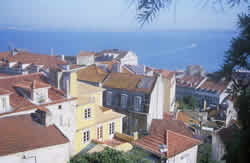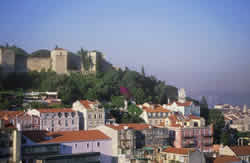|
Learn about Lisbon, Portugal, by reading
Lisbon's
New Age of Discovery by Gary W. Bloom, WTA Member and
Leisure Traveler/Writer. It features all you'll need to know to
plan your trip including how to get there, objective information
on places to stay, and eat, and things to do. At the end of the
article, we've provided a summary of the contact information for
your easy reference. Enjoy!
Lisbon's New Age of Discovery
By
Gary W. Bloom, WTA Member and Traveler/Writer

A picturesque
view
of The Alfama of Lisbon, Portugal
There is a popular saying here that "Portugal is Lisbon
and the rest is just landscape." The city's historic
importance and beauty are without question, with most travelers
agreeing that it is one of the most beautiful cities in the world. Lisbon's name derived from Latin
means "delightful little port." It may not be so little
today, with over one million residents, but it is every bit as
delightful. The city is centered on the river Tagus, whose path
leads 500 miles from Spain to reach Lisbon and the Atlantic. The
river's importance to the city was so great that streets are
numbered according to their position in relation
to it.
Lisbon is one of the oldest cities in the world. There were
settlers here as early as 7000 BC and by 3000 BC the city was a
thriving seaport. The Phoenicians first occupied the area,
followed by the Greeks, Romans, and the Moors. Lisbon became
Portugal's capital in 1255. During the Age of Discovery, the
explorers embarked from Lisbon in search of far off lands.
Portugal's empire expanded not so much from practical and planned
conquests as by its explorers' accidental discoveries. The voyages
of Vasco de Gama and other Portuguese explorers gained territories
in Africa, India, Brazil and Macao. Portugal ruled Macao until
1999, the last European power in Asia after Britain left Hong Kong
in 1997. Lisbon is the architectural benefactor of the riches
spent on monuments, palaces, and churches by the once mighty
empire.
Lisbon was on top of the world in the eighteenth century. A
thriving port and center of trade with Portuguese territories
throughout the world, the city was a showpiece for the powerful
empire. All that changed on November 1st, 1755, All
Saints Day, when much of the city was leveled and 40,000 people
died. Only two sections of Lisbon were largely spared - the Bairro
Alto and the Alfama. The Alfama, or Old Quarter, has changed
little since medieval times. The coat of arms above many of the
doors here attest to its once rich and noble past. It is now a
working class neighborhood, home to fisherman and sailors and the
legendary fado, the song of the Portuguese people. Like the Alfama,
fado speaks of a
squandered past. Fado, which means "fate" in Portuguese,
is a song of nostalgia and despair for what has been lost and what
might have been. Portugal, now relatively obscure, was once one of
the mightiest countries on earth.
The Alfama is a labyrinth of narrow stone streets, archways,
stairs, and courtyards. Carts of fresh fish are displayed outside
groceries and laundry is hung to dry on balconies. Small
closet-like shops are chiseled out of the concrete walls, selling
bread, wine, and other day to day staples. The streets of the
Alfama, barely 4 feet wide, were designed for horses. The houses
are just inches apart, inspiring the Portuguese poet Frederico de
Brito to write, "Our lips easily meet high across the narrow
street." The houses are encased in beautiful azulejo tiles.

Lisbon's
Saint George's Castle
The Alfama is home to Saint George's Castle, Lisbon' oldest
structure. The Castle rises above the Alfama and gives one of the
best views of the city. The Moors built the Castle in the ninth
century and the site was once a Roman outpost. When the Portuguese
re-conquered Lisbon, the castle was turned into a royal palace.
Many of Portugal's most important historical events have taken
place within the Castle's walls. Kings have been born here, and
Vasgo da Gama was received at the castle after his historic voyage
to India.
Like the Alfama, the Bairro Alto is a step back into Old
Lisbon. But whereas the Alfama is a working class neighborhood,
the Bairro Alto is filled with small bars, discos, and cafes. It
is the center of nightlife in Lisbon. The area attracts a literary
crowd, and is home to many of Portugal's prominent writers and
artists. With all the trappings of modern life, the Bairro Alto
preserves the cobblestone streets and ancient buildings that make
it one of the most interesting sections of Lisbon. At night, the
mournful sound of fado can be heard echoing through the narrow
streets. Walking through the Bairro Alto one can imagine Lisbon
during World War II when spies from all over the world converged
in the small bars and cafes of the city. The Bairro Alto area
still offers much of the intrigue and mystic of its cloak and
dagger days, though now its many watering holes are filled with
conspiring journalists, poets, and artists.
The western suburb of Belem, at the mouth of the Tagus and
the beginning of the vast unexplored Atlantic, was the starting
point for Portuguese navigators facing the dangerous ocean. During
the Age of Discovery in the late 15th century the explorers left
Belem in their caravels in search of new worlds. The Belem Tower
was the last familiar site for many of these explorers.
Constructed in 1520 to house cannons to defend the Tagus river and
Lisbon, the tower has been used to house political prisoners in
the past, but now contains an exhibition of ancient armor and
weapons. Before the Tagus changed course, the tower was situated
far out into the water. It is closer to land now, but you still
must walk across a drawbridge to reach it.
The Jeronimos Monastery, also in Belem, was built in 1502 on
the site where Vasco da Gama prayed before his voyage to India. It
is a symbol of the great voyages taken by the Portuguese in the
15th century. King Manuel I built Jeronimos as a dedication to
Portuguese explorers. Lining the nave of the monastery are the
tombs of Vasco da Gama and Luis de Camoes, Portugal's greatest
poet. It was the sale of spices brought back by the explorers that
financed the monastery. The nautical influence is everywhere. The
columns in the cloister behind the Monastery are in the shapes of
ropes and barnacles and there are carvings of shells and fish
everywhere. One section of the monastery houses Portugal's Naval
Museum where models and full size Portuguese fishing and
commercial boats are displayed. Not far from Jeronimos is the
Monument to the Discoveries, opened in 1960. This sculptured
caravel has statues of Portugal's most important explorers, with
Prince Henry the Navigator at the bow. The Coach Museum, one of
Lisbon's greatest attractions, is also near the Jeronimos Church.
Housed in an 18th century riding school, the oldest coach on
display here carried Philip II of Spain to Portugal in the late
16th century. The Coach Museum is considered the best museum of
its kind in the world.
Lisbon has become virtually unknown among today's travelers.
The relative obscurity has made this one of the least expensive
cities in Europe to visit, as well as one of the least touristy.
Yet most visitors rate it as one of the most interesting and
beautiful cities in the world. Maybe Lisbon's Age of Discovery is
just beginning.
Details
Getting there:
Portela Airport is about 20 minutes
north of Lisbon and is served by many airlines including Alitalia,
British Airways, Air France, Delta, TWA, Continental, American,
KLM, and Swissair. TAP (Air Portugal - https://www.flytap.com/en-us)
offers flights from a number of US cities, including New York,
Newark, Boston, and Los Angles. Airfare varies widely, depending
on airline and schedule, but as of June 2001, round trip flights
from the US were available for around $400.
A direct flight takes under 7 hours
from New York.
A taxi from the airport to the city
center is about 1500 PTE (about $7 USD).
Where to stay:
-
Hotel Da Torre
Rua Dos Jeronimos 8
Lisbon 1400 Portugal
Phone: 011-351-1-361-6940
Doubles are about $US 68 to $US 71, including breakfast. This
small three star hotel, decorated with nineteenth century tiles,
is located near the Jeronimos Monastery.
-
Mundial Hotel
Rua D.Duarte 4
Lisbon 1100 Portugal
Phone: 011-351-1-884-2000
Doubles are about $80 to $100 USD depending on the season,
including breakfast. Modern Four star hotel located in the city
center in the main shopping district, near Rossio Square and the
Tagus River.
- Hotel Tivoli
Avenida da Liberdade 185
Lisbon 1298 Portugal
Phone: 011-351-1-319-8900
Considered by locals to be the best hotel in Lisbon, it is located
on one of the most fashionable avenues in town. This five star
hotel's regular clientele includes film stars, writers, and
statesmen. Doubles run from about $125 USD to
$190 USD depending on the season.
Where and what to eat:
The Portuguese diet relies heavily on
seafood, with cod in its many variations considered the national
dish. Grilled sardines are another specialty. Shellfish dishes,
while more expensive and harder to find, are another good choice.
Portuguese beef is not considered to be the best, but pork
and roast kid are readily available and of good quality. Portugal
is, of course, famous for its port wine, but its red and white
wines are also excellent.
- Restaurante Tavares
Rua da Misericordia 37
Phone: 011-351-1-342-1112
Lisbon's oldest restaurant, founded in 1784. Once the leading
restaurant in Lisbon, it has lost some of its status to up and
coming competitors, but is still a favorite of diplomats and
writers. Main courses include salted codfish, veal, sole, and crab
dishes. Open from 12:30-3pm Monday - Friday and
8-10:30pm Sunday - Friday.
Prices are around 7,000 escudos (about $34 USD).
- Restaurante O Faz Figura
Rua do Paraiso 15B
Phone: 011-351-1-886-8981
One of the most beautiful dining rooms in Lisbon, with a verandah
overlooking the Tagus. Located in the Alfama, this moderately
priced restaurant serves typical Portuguese food, such a shellfish
stew. Prices are around 3,000 escudos (about $15 USD). Open from
Monday - Saturday from 12:30-3pm and 8pm-midnight.
When to go:
Like most of Europe, the winter months
provide the best bargains and the fewest crowds. But unlike other
parts of Europe, Lisbon has moderate temperatures during the
winter, although this is its rainy season. Spring or fall travel
usually provides the best weather with lower prices and fewer
tourists.
Getting around Lisbon:
English and Spanish are both widely
spoken in Lisbon. Taxis are inexpensive and readily available, but
Lisbon is small enough to be easily navigated by foot. The tram is
also a fun way to get around the city.
Dollar value:
Lisbon is one of Europe's least
expensive cities, and the strong dollar has made it an even better
bargain. The currency is the Escudo. As of May 2001, 1 American
Dollar was worth about 204 Portuguese Escudo.
Attractions:
-
Saint George's Castle (Castelo Sao
Jorge)
Rua da Costa do Castelo
Phone:No phone
Free Admission.
Open: Apr-Sept daily 9am-9pm; Oct-Mar daily 9am-6pm.
- The Jeronimos Monastery
Praca do Imperio
Phone: 011-351-1-362-0034
Admission: 500 escudos (about $2.20).
Open Tues. to Sun., 10 to 5.
-
Naval (Maritime) Museum (Next to the
Jeronimos Monastery)
Praca do Imperio
Admission: 400 escudos (about $1.78).
Phone: 011-351-1-362-0010
Maritime Museum -
http://www.golisbon.com/sight-seeing/maritime-museum.html
Open Tues. to Sun. from 10 to 5 (10 to 6 in the summer). Closed
Mondays and National Holidays.
-
National Coach Museum (Museu Nacional
dos Coches)
Praca de Afonso de Albuquerque
Phone: 011-351-1-895-5994
Admission: 450 escudos (about $2).
Open Tuesday to Sunday from 10 to 5:30. Closed holidays.
More
Information:
Notice: This information is current as of
May 2001. It is recommended that you contact the numbers, and/or
visit the websites above to determine any changes to the
information.
|